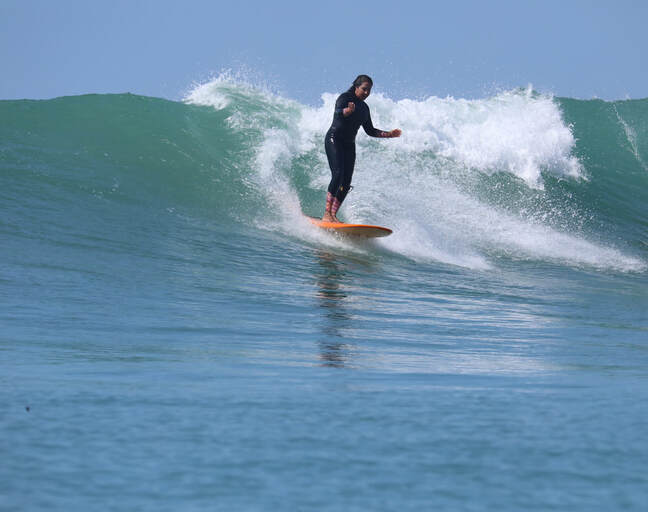and 3 ways we keep the conversations going.... I started Surf Life Executive Coaching with one mission: to help creative leaders transition to a life and business filled with purpose, choice and impact in service to their values, the well-being of humanity and our planet. Three years into my coaching practice, I began to attract a community of curious and talented architects and designers. They had big visions for their leadership and career, but they were burnt out, discouraged, anxious and unsure of the path ahead. They wanted to see if there was a better way forward to achieve personal and professional success and fulfillment. Just as they were designing innovative spaces in the tangible world, they wanted to design their work and their leadership in alignment with their values and purpose. They wanted to get clear on the legacy they wished to leave in the world as a technical creative.
In the 9 years I’ve been coaching architects and designers, these have been the three driving questions they are trying to figure out: 1. Where am I going and how can I get there? An architect I coached was laid off from her senior corporate position. She was trying to figure out what her next step was going to be. With a little nudge from her husband, she began her coaching journey. In the process, she got clear on what she really wanted, which was to pivot to interior design. She also got clear she wanted to do it on her own terms by starting her own firm. And that’s exactly what she did. She successfully started her own design firm which she has been running for eight years with design projects all over the world. 2. How can I get my confidence back? Another architect I coached had undiagnosed ADHD throughout her career. She really struggled to function in a corporate architecture setting because of the high pressure and constant deadlines required of corporate life. She transitioned out of corporate to start her own firm. She was also able to get a proper diagnosis and treatment to manage her ADHD. But she lost so much confidence during her corporate tenure that she struggled to find the confidence to run her firm. She turned to executive coaching where she spent a year doing the internal leadership work needed to grow her confidence, implement creative systems that work for her in her practice, and learn strategies of managing and getting the best out of her people. As a result, she was able to start to attract the types of projects that truly resonated with her, in addition to growing her firm’s revenues. 3. How do I feel better? Another talented designer and architect took the plunge and started his own firm. Barely three years in, he was run down, agitated, lacked any work life balance, and felt constant anxiety about the business. Moreover, he would run the business on adrenaline and dopamine rushes versus growing the practice in a steady and consistent way. This took him to coaching. He spent a year developing internal emotional resilience and learned how to better self-regulate through the ups and downs of firm leadership. He learned how to manage staff with realistic expectations. He also developed a creative vision for a life of running his architecture firm which included teaching architecture and traveling the world with his family. He’s currently planning to spend his next summer with his family in Spain! Before coaching he could not even dream this was a possibility. Though faced with different challenges, these architecture leaders all relied on core foundational coaching processes to overcome their challenges to attain clarity, confidence and calmness in their leadership and life. They clarified and made decisions based on their values. They clarified their purpose and what they stand for as architects. They articulated and shared their design philosophy and better integrated it into their practices. They met the many internal voices that were constantly dialoguing within – from the voice of doubt that kept sabotaging their dreams, to the voice of confidence and competence that said “damn. I nailed that design.” Most importantly, they developed a clear vision for who they wanted to BE in the future as a technical creative – what I like to call their Future Architect Self. Coaching specific to architects and designers seeking answers to the questions that drive their careers works! The testimonials speak for themselves. Interested in being part of leadership conversations with other inspiring architects and designers to figure out a better way forward to professional and personal fulfillment? See how to get involved with Surf Life below! 1. Surf Life for Architects and Designers: Conversations on Leadership and Life (Linkedin group) Surf Life for Architects and Designers: Conversations on Leadership and Life is my new Linkedin community just for architects and designers to explore how to use your creativity in service to designing a leadership and life that speaks not only to your head, but to your heart. I invite you to join in the conversation here! 2. Surf Life Foundations for Architects and Designers: Online Coaching Program Spending the past nine years working with talented architects and designers like these and getting results is what inspired the creation of Surf Life Foundations for Architects and Designers. This is an online course designed to give architects and designers an easy way to start getting leadership coaching and to tackle answers to their professional leadership and life challenges. The online course consists of five foundational comprehensive modules delivered over five emails, allowing architects to delve into important topics such as identifying their values, connecting with their inner leadership voice, managing their inner critic, gaining clarity on their purpose, and meeting their Future Architect Self. Now, any architect or designer interested in growing their leadership can access these tools and begin their leadership coaching journey. 3. Surf Life Executive Leadership Coaching for Architects and Designers 1:1 Executive Leadership Coaching with Surf Life is a program designed to provide in-depth, transformational coaching to help leaders in architecture and design unlock their potential so they can operate with more clarity, confidence and calmness. The program includes 1:1 coaching, an interactive toolkit of coaching exercises and practical management tools to empower architects and designers in building their leadership skills, and powerful guided visualizations. It also includes neuroscientific explanations of coaching exercises, so even the most skeptical leaders understand not only what they are doing in leadership but why they are doing it. Leaders who have completed this program are 3 times more likely to meet their business and transition goals based on this system. Visit Surf Life Executive Coaching for Architects and Designers to join in on the conversations!
0 Comments
Early in my career I once managed a high performing leader who would often express feeling overworked and unsure of their role. In an effort to solve the problem, my gut reaction would be to try to control and fix. I’d come up with a list of parameters on expectations and try to clarify roles. I’d give guidance on where to spend more time vs. less. I’d wrap the issue up like a present, tie it with a pretty bow and then put it on a shelf. Problem solved. Or so I thought. The same theme with the same person would resurface. And I noticed I’d become increasingly exhausted trying to solve it. In hindsight, I realized what I was really missing in solving this was one thing: curiosity. What was needed was for me to get curious and ask of them questions like: What do you really want? What would that look like? What do you need more of/ less of from me? How can I be a better manager to you going forward? Instead of burdening myself to solve the recurring issue with excel spreadsheets, roles and task lists, an easier path was to help this capable leader get clear on what it actually was they really wanted. I’d come to understand that underneath the real issue was their desire to be recognized for their contributions in a way that was meaningful to them. Underneath it was their wanting to express what they needed to thrive as part of our team. What they needed was a collaborative process that was relational, taking into account how WE worked together. Now as an executive coach for over ten years, when I see managers default to the exhausting control and fix mode of management, I challenge them to cease being a fixer and to become more of a coach. Solving the hard issues requires getting to the bottom of the issue. And getting to the bottom of an issue requires of us to be engaged and curious. Sometimes what’s needed is less “that’s yours and this is mine” and more “together we are.” Farhana Huq is an Executive and Leadership Coach, Surfer, Global Explorer, and Founder of Surf Life Executive Coaching and Brown Girl Surf
I’ve been writing a lot of late about the non-profit I ran of 11 years that closed. It had a worthy mission to economically empower immigrant and refugee women through entrepreneurship and English training in the San Francisco Bay Area. After 10 years running it, I took a sabbatical for rest and much needed time off. Upon returning, I came back to a skeleton of an organization that was running a $50,000 deficit, all occurring while I was gone. There were many narratives as to exactly why we ended up in this position. The interim leader’s narrative ranged from ‘I was left to manage a house of cards’ to ‘the staff was not matched in the right positions for their skill sets’ to ‘our board chair wasn’t strong enough.’ Some of the Board Members’ narratives were ‘you can’t leave for 4 months and expect everything to be hunky dory’ to ‘you left a COO in charge, not a CEO’ to ‘you didn’t share with us how much this was being run like a start-up.’ Some staff outright blamed the interim leader, some the Board. The most corporate members of the Board blamed me, because to their mindset, the buck stops with the CEO. Forget about any non-profit, “kumbaya” notion of shared leadership. It was a terrible time trying to stay afloat amidst a whirling sea of vastly different narratives. As well, there was the backdrop of the recession we were in at the time, which was more fact than narrative. After having ample time to reflect, heal, do my own internal work, what became apparent to me was that I never really formed my own narrative in the process. I listened to everyone else’s. At one time, I had been the outreach person for this organization, the programs person, the grant writer, the major gifts fundraiser, the website developer, the bookkeeper, the computer tech person, the visionary leader. I grew an idea I started from my bedroom desk when I was 24 years old with $1,000 into an incorporated non-profit organization with an official Board. I was the one person with 360 degree experience of the entire enterprise. And much like a deer in headlights, I was so caught off guard coming back to this I could not even form my own narrative. While having my own narrative was important to me in making sense of this all, I also learned that when things go South like this, it never is about any one person’s narrative. Ask anyone and they would all have a different perspective as to the “why” of this situation based on their own life experience or values. To them, their version IS the truth. As a leader looking back on this, I can say the learning is that we have to take responsibility and accountability for each of our roles in leadership. The learning is that nobody is perfect. The learning is in believing everyone did the best they could in the given circumstances, recession and all. Sometimes that is all we can do. We should own up to our shortfalls versus passing the blame and trying to justify why something wasn’t our fault, or our responsibility. We should understand we were all accountable in some way, and that for great ideas or organizations to thrive, the leadership must be shared. Going forward, I choose a no frills narrative of “what’s so. “ What’s so is I founded and ran a great non-profit, co-built together with wonderful colleagues, Board members, advisors, funders, volunteers and staff. What’s so is I went away for a much deserved break on a Board approved sabbatical. What’s so is the organizational leadership was not able to raise sufficient funds or effectively orchestrate the team to achieve their goals. What’s so is upon my return, we attempted to merge the organization with a larger non-profit. What’s so is we were unable to do so for various reasons, including the recession. What’s so is we closed. What’s so is I learned the lessons of a lifetime. That’s what’s so. Farhana Huq is an Executive and Leadership Coach, Surfer, Global Explorer, and Founder of Surf Life Executive Coaching and Brown Girl Surf
Journal Excerpt: The Fall of C.E.O. Women, The Start of brown girl surf December 18, 2011 I’m alive and I have all my limbs so I’m trying to put the closing into perspective. A lot has been done to dismantle the (C.E.O. Women) office. We’ve sold most of our assets last week and this week is the final push. The only thing is that we have no staff left – I’m the only one and so I have to manage all of the following:
I sent this list to my board chair and treasurer to let them know … But as it is, I’m left as the only one trying to manage the final three days of closing of the office. People expect way too much when you are a Founder. The good news is that I raised an extra $15,000 from foundations and donors and that the government approved our $20,000 reimbursement request so we will have enough for payroll, which will limit the board’s liability. They were going to float a loan for payroll as well which I was happy about but now they don’t need to. My friend and board member gave me a $1,750 (personal) loan to tide me over until we can collect on all the grants. … I have been actively trying to find a home for Grand Café in it all … because we owe the bank for our line of credit … It is a hard decision because that is nine years of work/research that went into building that asset (and $500,000) and I’m not sure what the bank will do with it at this point but I want it to land somewhere good, but I also want this to be done, so I’m torn … I have been surfing which I’m glad about but skipped my Friday session down in Santa Cruz as I normally do. I just felt like last week was intense and I couldn’t focus so much on my surfing, but I did get out on Friday and Saturday to Ocean Beach which I was really glad about. I also started to get a lot of momentum on brown girl surf … I am so proud of the (web) site and honestly it has been like therapy. After coming home dismantling an 11 year old non-profit I built on my back, I can work on creating something new which gives me a lot of energy. I’m excited that I am so excited about this … … If it weren’t for surfing and brown girl surf, I’d be in bad shape I think. But I feel calm and collected … but I just want this saga to be over with … I have such a wide range of emotions regarding the board that it’s hard to make sense of them. On the one hand, I have felt left in a lurch by them all year – only half of them fundraised and did what they could … On the other, they are my personal contacts and networks, and amazingly, not one member resigned since the crises … most of them have given or raised significant donations (totaling over $96,000) … So it’s not bad for a small board … I’m glad that brown girl surf will not have one going forward. I just want to be free from this all - free from the blame, free from the stress, free from this identity that I have held for what seems way too long. I am Farhana and I am the Founder of C.E.O. Women, but it is not my baby and I don’t feel that way about it … … It sucks being a Founder. Your DNA is imprinted into the organization and work until the day you leave/ relinquish it but I feel trapped and not in a position to relinquish at this point. I can’t wait until it’s all over. I can’t wait to run with brown girl surf and it’s exciting to see it come alive … Farhana Huq is an Executive and Leadership Coach, Surfer, Global Explorer, and Founder of Surf Life Executive Coaching and Brown Girl Surf
I founded and ran a non-profit organization for 11 years with an amazing mission – helping low-income immigrant and refugee women to become entrepreneurs and learn English. After 10 years of running it, I took a needed sabbatical to reflect and rejuvenate. An interim leader led the organization in my absence. When I returned a few months later, it was operating a $50,000 deficit, the first ever deficit in the history of the organization. As a Founder, this was devastating. It was like coming back at halftime to a 0-4 World Cup game and you’re on the losing team. It’s not impossible to bounce back, but it would take a level of effort I did not have in me after an already exhausting 10 years. The organization eventually closed. My last official day was the 21st of December eleven years ago. While I made peace with the closure, I never quite got over the loss of its most innovative program - a soap opera series designed to teach English and entrepreneurship skills to immigrant women. I worked on this idea for 9 years, raising about half a million dollars to develop 6 of 18 episodes. Upon closing, the series was given to the bank as collateral for a line of credit that leadership took out in my absence in order to finance the deficit. Giving over the program felt like a miscarriage, like it never got its fair chance to run. And truth be told, perhaps it was a little too early of an innovation for its time. Many funders resisted the idea of a remote, media-based learning program, now an ironic sentiment in these Covid times. This summer, on a long shot, I decided to reach out to the bank. I asked them to release the program series for me to resurrect. They agreed with full support. It was one of the best pieces of news of my career and life. If I learned anything through this experience, it’s to not lose faith in your ideas. Ideas take courage. Creativity takes courage. Speaking up takes courage. Honoring and holding worthy your ideas takes courage. And perhaps most of all, I’ve learned that there’s no timeline for courage. You are ready when you are ready. While I worked on this idea for 9 years it was the amazing team around me that brought it to life. Angelica Matsuno was the ah-mazing Co-Producer and Co-Writer who has been helping me to resurrect it. We were probably the most attached emotionally to this project. Nina Serrano was the incredible writer of the series and Marissa Aroy was the talented Director along with the ever capable Producer Niall McKay who all used their artistic skills, creativity, time and talent to give this idea life. There was also the programs team that worked on distribution, countless advisors, board members, clients and volunteers who helped take the idea to where it was. I’m forever proud of the work our organization did. And I am proud to return to this creative idea, with new eyes and wisdom, in service to all the people it was meant to impact. To view the program trailer, see below: I used to think that vision was mere “fluff” - not worthy of much work and time. It was more important to execute and provide products or services because those were more measurable and important at the end of the day. To me, investing time in creating a vision seemed extravagant at best. After transitioning out of a 15-year career as a non-profit leader and executive, I all of a sudden found myself without a North Star. I kept thinking of ideas and ways I could make things look different with a business or project, and I’d follow through by getting into full execution mode. But what I realized was that I was lacking a fundamental vision for my life. I know, how sad - a life with no vision. Mind you, I generally have lots of ideas – at times too many for my own good! It was as if I was executing projects and ideas, but I wasn’t sure exactly how they all tied in to the bigger picture of things and to my greater purpose. Have you ever had that feeling? Well, that feeling inspired me to share with you a few things I learned along the way about the importance of personal vision, and some steps you can take to craft yours and bring it to life, even when it seems far off! Step 1: Believe first. During my coaching journey, I discovered there was a neuroscientific explanation for the importance of vision. The scientific explanation came from Srini Pillay’s TEDx talk , a resource I have mentioned a few times in my previous posts. In short, Srini talks about the brain as having its own internal GPS system; our neural tissue actually has the ability to direct us towards our goals and vision as we take in information. This inputting of information into our “internal GPS systems” happens at a subconscious level. He notes that knowing our history and where we came from as well as utilizing our imagination and vision activates this action center in the brain, helping us move from point A to B. It’s no wonder vision is so stressed in organizations and the business world. If you think about it, as humans, we can’t organize ourselves in the right way without knowing what it is we are organizing around, whether personally or for someone else. Our minds work in a similar way. Pretty cool, eh? When I learned this, my previous assumption about “vision” turned from fluff to form, and certainly gave me something more marshmallow-like to chew on. So if you haven’t already, I’d highly suggest watching this awesome talk by Srini Pillay, called “The Science of Possibility”. It helped me understand the impact that visioning and imagining into the future has, and how vision can help us achieve our goals. Step 2: Understand the benefits of crafting a vision. Have you ever gone to an advisory meeting for a new start-up or a meeting at a place you’re volunteering for, and there was nobody there talking about the bigger picture purpose of the work? Perhaps you found yourself mired in the weeds of the “how-tos”? How did you generally feel? Inspired? Ready to roll up your sleeves and jump in? Lost? Smart leaders know that to keep people following, they must be able to hold a compelling picture of what could be in the future. Being able to point towards a North Star or greater mission helps connect and give our tactics and actions purpose. When we are able to hold a vision for ourselves in our lives, we become clearer about our own trajectory and transition. The clearer we are about our trajectory, the more likely we’ll be able to attract the resources we need towards it. Crafting a very personal vision is beneficial in the sense that you are creating an internal roadmap for the way forward; as a result, you spend less time on things that aren’t going to lead you straight to that vision. Take sports, for example. Growing up as a competitive athlete and member of the U.S. National Karate Team, I trained a great deal for competition. In the summers, I would do intensive training comprised of physical, repetitive regiments to prepare for competition. But when it came down to the pressures of actually competing and performing, it was the visualization and meditation work that paid off the most. Seeing myself go through my katas (forms) and winning matches was critical in helping me achieve and meet my goals. What I was doing was training both my body and mind to see the goal. Without the visioning, it would have been very difficult for me to succeed with just technique alone. So you can have all the skills in the world, but without personal vision, you may not succeed in achieving your purpose. Step 3: Employ visualization. Finding clarity in a vision is one of the hardest things for people in transition. Visualization can be a helpful tool in this realm. Very often, it’s necessary to go through a process, either with a coach or in a workshop setting, where you can experience a guided visualization process for what you want your future to look like. I remember when I was starting my coaching business and I was trying to reach a very broad base of entrepreneurs and leaders. I was struggling with how to market my services, as it felt like I was reaching out to so many different groups of people. My coach at the time had me do an exercise. She asked me to close my eyes and to imagine myself 5 years into the future. She asked me where I was working, how I was working, and by whom I was surrounded . I saw myself living in something akin to a very cool, somewhat Bohemian-looking treehouse, with all the amenities of a conventional house (yes, that’s really what I saw!) by the beach. I was running retreats, surfing and coaching executive women leaders. It was that clear. That’s when it hit me that I needed to really focus on integrating surfing more into my work coaching clients. This shifted things enormously for me. I went from feeling scattered to knowing who to target and what to communicate to my clients. There is a saying that you should start with where you want to end up. The benefit of getting clear on your vision is that it can tell you precisely where to start. In my work with clients, I often have them close their eyes and ask them to envision where they are working 3 or 5 or 10 years into the future, however far they are willing to go. I ask them to envision who is around them, and what those people are saying. This exercise helps them to gain more clarity on where they see themselves. I highly recommend engaging in a process like this. Step 4: Break it down, day by day. It’s not enough to have the vision; you have to find a way to break it down into daily to-dos, while always keeping the vision front and center. One of the practices I employ during my daily routine is listing the things that are going to make me the most happy and productive for the day. I do this with the intention of executing on my action items. I first start by writing down all that I am grateful for that day about my business and life. I then list what I want my dominant feeling to be that day – examples are happy, sad, determined, focused. And then I list the 5 or 6 things that I need to focus on that will make me the most happy and productive on that day. Like an athlete, I set my intention for the course and regiment of that particular day. This is followed by a process of setting a wild intention - an ultimate dream - which I write down as well. I learned this from a fellow coach and it has done a lot to help me get me focused in my days and proactively working towards my vision. When I started thinking about offering a Surf Life Executive Coaching retreat, I was somewhat terrified of doing it. What if it all goes wrong? What if I don’t get people to sign up? But holding to and returning to that vision each day and including steps in my process above is what helped me eventually launch the program here in Northern California. Step by step, I broke the vision down, and I slowly completed the planning and logistics necessary to hold the retreat, keeping my ultimate vision for it in mind the whole time. I can't stress enough the importance of vision in our life and business transitions. It can pay off innumerably to spend time crafting your North Star. Now that I've shared my thoughts on vision, I'm curious, where has vision played a major role in your life or transition? What tactics and resources have you used to help get clarity for your vision? I'd love to hear your thoughts! Like what you read? Subscribe to my newsletter!
Some of my first experiences with leadership began as a 14-year-old, when I started teaching martial arts classes for adults. I learned the importance of leading by example. I learned what it was to be in front of adults who were relying on me for guidance and support to grow their skills.
In my 20’s, my leadership journey further expanded after founding an organization that gave me the opportunity to not only grow and exercise leadership in ways that continually stretched me, but gave me the honor of working alongside some of the greatest, most courageous people I’d ever met in my life, from fellow scholars, small business owners, to social justice leaders, to corporate CEOs. After really thinking about this journey of leadership, and some of the characteristics of great leaders I met along the way, it was hard not to think of surfing. The similarities are uncanny, actually. Who would have ever thought surfing could be such a window into greatness? Below are 11 great leadership qualities I have seen in action over the years. 1. Great leaders commit to their word and follow through: In the way a surfer commits to a wave at the time of takeoff (the point where the surfer catches the wave and pops up on the board), when great leaders say they are going to do something, they actually do it. They commit to their word. When something changes on their end, they communicate it out or give advance notice. Doing what they say they will do builds absolute trust and confidence in their word. 2. They have balanced energy: Balance is at the foundation of surfing and is a quality I have observed in the greatest leaders I have met. They have a calm, balanced energy about them and are able to be fully present with you in the moment, even if they are extremely busy. They possess a balanced and inviting way of doing things. Many of them have a practice (yoga, running, meditation) or something that keeps them grounded. That energy is felt when you are with them. 3. They know when to be old skool: Great leaders are skilled in the art of relationships, and more importantly, they just know when to pick up the phone, old- skool style. They don’t send long, diary-like e-mails expressing their feelings and frustrations with a laundry list of things you did wrong or how they feel wronged. When shit goes down, they pick up the phone. They are courageous. They confront things head-on and know when a face-to-face conversation is warranted. Relationships matter to great leaders, and they know how to manage them. 4. They choose creation over victimhood: Great leaders have a creation vs. victim mentality. This means they focus on the ride – the art of carving through the wave - even if the wave is monstrous and gnarly. They are self-accountable and don’t blame others for their situation or their wipeouts. If something doesn’t go as planned, they regroup, try again, shift strategies and embrace a growth mentality, learning from the process. 5. They possess a passion for their craft: Much like a surfer, great leaders have a passion for their craft. They put the best intentions of the issue, cause or organization before their personal agendas. 6. They understand the greater powers at work: Like surfers who understand the power of the ocean, great leaders understand they are minute in the big scheme of things. They know when to be humble and lead from behind, and how to manage a healthy ego while being at the helm. They know how to use their ego selectively. 7. They are courageous: Like a big wave surfer tackling the world’s scariest waves, great leaders are courageous in their ability to confront uncomfortable situations and have those difficult conversations. They face their fears, and by standing in their power and speaking their mind, they are able to come to new understandings with those around them. 8. They are versatile: A surfer can be versatile in her ability to surf many different types of surfboards through many different types of conditions in the ocean. In the same way, great leaders tend to have broad experience in various aspects of their craft, and are versatile in what they do. Some of them may have started doing the most menial thing, but learned the ropes along the way and know what it feels like to be in the shoes of the people they are leading. 9. They respect others: As surfers learn to have a healthy respect for the ocean, great leaders operate from a baseline of respect for people, including their rivals. They are not the type who go around making up names for a colleague or boss, or talk badly about someone behind their back. They hold respect for others and know how to communicate their position, even if it is at odds with someone else’s. 10. They are able to see trends through multiple perspectives: A surfer goes through many perspectives – from assessing conditions on the beach, to being in the water taking the drop, to being in the ‘zone’, to duck diving under the wave. They are able to be in all perspectives. Great leaders are also able to be in a range of perspectives, understanding that not everyone will see something the way they do, but knowing how to cull the “trends” from varying perspectives around them. 11. They are curious: Just as surfers cross borders, curious about the next kind of wave they will encounter on the horizon, great leaders are curious. They never assume anything, and know how to approach issues from a place of curiosity. They know how to ask the right questions from this rich place of curiosity. What are some of your observations of great leadership? Like what you read? Subscribe to my newsletter!
(Part One of a Three Part Series on Anxiety)
I’m not an expert on anxiety, nor do I claim to be. But I do have some nuggets of insight to share. What I do know is that feeling anxiety is part of our neurological wiring; it is not necessarily a bad thing. Then there’s the anxiety present in situations that can preoccupy you and keep you from functioning to your best abilities. And then there’s debilitating anxiety – the kind that some may treat with prescription drugs. My experience and sharing is geared more towards the first two kinds of anxiety. Specifically, I want to share what I’ve discovered in study and in coaching leaders that have grappled with anxiety. I’ll share one example. I once coached a senior leader who struggled with anxiety on a daily basis. It was present to the point that she would avoid confrontation due to discomfort and anxious feelings. Somewhere in the middle of our 6-month engagement, she confided that she had tried therapy, somatic bodywork and even working with horses as ways to help her manage the anxiety she felt. However, she felt our coaching process was the thing that really worked for her. So, what exactly did we do that was effective for her? First, let’s start with a little context. Lisa Feldman Barrett, neuroscientist and author of How Emotions are Made, has done some groundbreaking thinking and research in the realm of emotions. In her book, she asks us to consider a new way of thinking about emotions, which I’ll apply here to help us think about anxiety. Based on her research and findings, emotions are predictions we make as we go through life. In other words, we predict how we are going to feel versus simply reacting to the outside world. Our predictions are based on prior learned concepts for feelings, our biology, and our experiences. We make the prediction of what is going to happen, and signal our body systems to allocate the appropriate energy and resources in that moment. This then translates into a concept or name of an emotion based on our past experience and how our culture and society helped us define this sensation. Our brain then engages in correcting for the prediction, based on what actually happens. This all happens very quickly. And hopefully, we then begin to predict more accurately based on past experience. However, according to Feldman Barrett, “Anxiety sufferers, for whatever reasons, have weakened connections between several key hubs in the interoceptive network, including the amygdala….These weakened connections likely translate into an anxious brain that is clumsy at crafting predictions to match the immediate circumstances, and that fails to learn effectively from experience. You might predict threats needlessly, or create uncertainty by predicting imprecisely or not at all.” So, if we view anxiety as an issue of prediction, we may understand our natural regulation system to be out of balance. From a coaching standpoint, the process then is about equipping the leader with sufficient tools to predict more accurately, lessening the gap between prediction and prediction error. In the case of my client, we first started out by helping her define a different way of being. We helped her define a powerful, internal, confident voice. We even gave it a name and a personality. In other words, I asked her, “What would your XYZ powerful voice say in such a situation?” so she knew how to call on that voice when she needed it. In coaching, it’s really important to separate out the many different voices and narratives that run through our minds, and to develop or strengthen the voices that serve us the most. Because, as you guessed it, different ways of being take in and process the world differently and predict different things! Then, we identified the thread of the negative, critical voice that aligned with memories of some of her anxious predictions. She recently shared with me in helping to edit this piece of writing that she felt her anxiety was not the result of any one relationship or given thing, but rather, a result of the complex combination of circumstances and environment in which she grew up. In one session, we practiced asserting herself more so she could effectively lead her team. I pretended to take the role of someone in her life she had felt anxious about with respect to meeting his or her expectations. I wanted her to confront me, to speak directly to me as if I were that person. So I asked her to step into her more powerful voice, to really feel it first. I stood in front of her. As she spoke to me, I pushed back with words that this person might have said to her. I asked her how she was feeling in her body. As she checked in with her feelings, we noticed her tendency was to want to physically move away from the interaction. With her permission, I asked her to step closer in front of me, and to pay attention to what was happening to her body. Then, I asked her to speak from her empowered voice to me. With awareness of her body, the more forceful, confident voice emerged. She stepped into her new, powerful way of being, moving towards me with courage vs. anxiety. In a session following, we practiced what she would say to a real person - one of the team members she needed to confront. In her logical, matter of fact way, she took a stab. I could feel the hesitation and fear in her voice and body. She was back to predicting self-doubt, anxiety and fear. We practiced some more, in her more powerful voice and went through various “what ifs.” What if he gets angry? What if he reacts this way? What if he says this? By going through various scenarios of what ifs, and checking in with her body, we worked on getting her comfortable with and expanding the possibilities for what she might predict from such an interaction. Before, she was stuck in an emotional prediction cycle around confrontation, based on her past experiences and who she was being at the time of those experiences. By stepping into a different way of being, as well as simulating scenarios for different possible outcomes, she started to alter the prediction her mind was so used to making around confrontation. It’s not that we got rid of her anxiety, but we gave her the tools to interrupt the prediction cycle she was so used to being in with respect to confrontation. So the next time she had to confront someone, she could do so predicting a different outcome. Our emotions are wired to concepts we are taught from the time we are infants, to old beliefs and to stories about our self-worth and ourselves. By exploring what we are predicting and paying attention to where emotions are felt in our body, we can start to empower ourselves to shift our feelings. Add to that a few coaching tools and simulation to help clients see other outcomes are possible, it’s possible to empower leaders out of their anxiety prediction loop. It does not happen overnight, and also takes great trust and safety within the relationship, but it is possible to start to change the way we predict, and in doing so, change our predictions around experiences that would have caused us anxiety in the past. Like What You Read? Sign Up for My Monthly E-news!
Oftentimes, you are able to see and make sense of things after the moment has passed. As someone who is passionate about leadership and change, these are topics I naturally reflect on when I have the space and time.
Here are some reflections on leadership that I was better able to realize when looking back on my experiences in various leadership positions I’ve held in business and in life. 1. Your attitude affects everyone As humans, we have the ability to identify and mirror the emotions and feelings of others as they are experiencing them. So, if you are feeling stressed out and angry over something, that may contribute to how you make others feel. If you doubt yourself and complain more than problem solve, that energy will trickle through to those around you. In short, as a leader, your attitude affects everyone. I remember one year on the day of a major fundraising event at the organization I ran, the fundraising team was frazzled and stressed out with last-minute to-dos. I was also stressed out from realizing an important detail wasn’t put in place prior to the event. As a result, our entire team was stressed, and this stress marked the entire first half of the day. As a leader, my behavior and attitude was perhaps the most influential to an already stressed group. Luckily, I had a co-leader that was calm about everything and helped balance out the frazzled energy of the crew. So, when you show up to an event or walk into the office for the day, know that however you feel can set the tone for those around you. It can mean the difference between people feeling excited and motivated about the day vs. unmotivated and grim. You have the power to create the environment you want to create. 2. Vision is a key pillar to success People need to understand where things are headed. I used to think vision was more “fluff”, and that it didn’t need as much time as the “doing” work and execution. I was once an active volunteer of an organization with dynamic people who were excellent leaders in many ways. However, whenever I asked what the vision was for the work, nobody could really define it clearly. And when they did provide an answer, the vision would change from conversation to conversation, like a moving target. This had a really demotivating effect on me, and I slowly lost interest in what it was I was doing there. To keep people following, there is an aspect of needing to help them understand the possibility of a future, and what could be different and compelling about that future. As a leader, you have to give people an answer to the question, Why? Otherwise, they will not be able to connect the doing of the present moment to the overall purpose or goal. 3. Do not compromise self-care The importance of self-care is something we are hearing more and more about, and it is a topic that I have been stressing in my recent posts. In the non-profit world, many organizations are influenced by the baby boomer attitude. This attitude is very much tied to the idea of having to "fight the fight", and that if you don’t, you are not seen as being really committed to the cause. The sentiment is not much different in corporate America. I often hear complaints from professional women that it doesn’t look good in their business culture to come to work at 9 and then leave a bit after 5 p.m. After all, how are they ever to move up? Many feel that it is expected of them to put in longer hours, even at a cost to their own well-being. The problem with this attitude is that it sets people up for burning out and for potentially deeply compromising their own energy which they bring to their work (see point #1). Ariana Huffington writes a lot about what it means to be successful and balanced in her new book, Thrive, where she talks about installing sleeping pods at her company so that employees can get rest if they need it during the workday. If you are not taking care of yourself as a leader, you are not setting a good example for your team members to take care of themselves either. This can result in feelings of guilt, resentment and burnout amongst your team. Moreover, you may start to resent your own situation and the work as well. But if you show up rested and ready to go, you will be that much more empowered to lead and really perform. If you are a naysayer in this department, I assure you that work and proper self-care can coexist. I know many successful women from corporate banking to non-profit that have succeeded in instituting very good structures to honor their self-care. I will be featuring some of them in the blog posts to come. 4. Follow-through builds trust, which builds leadership Ever have those team members who constantly drop the ball? How do you feel about them? Feel like following them, or pushing them off a cliff? This point is something I learned from a colleague of mine while volunteering for an organization right out of college. She was a very talented person who always said she would get something to me by a certain date. That date would come and go, and she consistently would not meet the deadline. When asked about it, she would get defensive and blame it on her circumstances and her upcoming trip, instead of apologizing and realizing how her follow-through was affecting the next steps of the entire project. She eventually owned her accountability and admitted to the shortfall and openly stated that this was something she was working on. Contrary to that, I had the pleasure of working with a leader at another organization who always followed through on what she said she would do. It was rare that a ball was ever dropped. And if she wasn’t able to do something on time, she would inform you prior to the date and re-negotiate the timeline. This behavior built great trust between us, and she was consequently seen as a credible and trustworthy leader in the organization. 5. Embrace discomfort I remember the first time I was asked to teach a dance class for a school I had been learning in for some time. I was only dancing for a few years and did not feel ready at all. I was placed in front of the class with minimal guidance. At first I resented the fact I was in this position. I didn’t feel ready at all. I tripped my way forward and improvised to get through the classes, only to realize in the end that I knew enough to actually teach the content to my students. Not only that, I discovered I was pretty good at teaching. As it turned out, teaching was something that helped develop my comfort in being in front of people, and later helped me greatly as a leader in my career. It is great to have a plan, and to be properly trained and prepared. However, in the world of entrepreneurship, that mode of working can sometimes seem like a luxury. Learning to make do and move on the fly was one of the most helpful muscles I had a chance to exercise that contributed to me being able to lead confidently through ambiguity. Feeling discomfort stretched me in a way I hadn’t been stretched before. And neuroscience tells us that this kind of stretching builds the neural networks that make it possible (and even less uncomfortable) to maneuver through other changes and unknowns. What surprising things did you realize about leadership after you became a leader? What would you recommend to emerging leaders going forward? I'd love to hear your thoughts! Like What You Read? Subscribe to my Newsletter!
There has been much talk over the years about the differences between the right hemisphere (RH) and left hemisphere (LH) of the brain. While we now know that it isn’t as simple as saying that creativity is more RH, or that logic is more LH and that both are needed for BOTH processes, we do know this: there are still profound differences in the way each side of the brain takes in the world around it. And this divide has profound implications in understanding executive leadership.
First, a Little Neuroscience Some basics: The LH is the hemisphere that allows us to see the detail, understand sequences and focus on the parts. Things like understanding metaphor, implicit meaning, and even the ability to read others’ emotions are correlated with the RH. The LH also can only see itself and what it already knows whereas the RH can see the whole of things and make connections. The RH also takes in all new information. This divide is perhaps most interestingly summed up in Iain McGilchrist’s TED talk on the divided brain.
Where Managers’ Brains Get Stuck
Good managers focus on pieces, parts, sequences. It is not their job to hold the whole picture—only the picture of their program or their part of the system. When they move into executive leadership, they often find themselves challenged to broaden the scope of their leadership. This often includes things like big picture thinking to feeling empathy for others around them. As a coach, I see this struggle reveal itself in language when leaders come to their coaching sessions and only speak from a place of “I,” often parsing out THEIR contributions, what THEY need and what would be best for THEM, instead of speaking from a place of “we” and acknowledging the bigger picture that is made up of everyone’s contributions. For the emerging executive leader, it’s no longer about just their personal performance or making a good program run well; their challenge becomes to look at all parts and functions in relation to the broader, implicit meaning of the whole business, organization or system. For example, I coach a leader who is running a consumer products business. Most sessions start with her feeling challenged about an operational issue and struggling with how to make people feel as if they have a stake. She sees each person as utility, rather than as someone to get to know, connect with, get curious about, empathize with, develop and grow. While this leader has a high ability to sequence, plan, execute, and solve immediate problems, she gets stuck in her LH, the land of "operationalizing" and “literalizing.” In this land, employees are seen as utility, and not whole beings to nurture, grow and develop. The impact is that the broader meaning of their employees' work is relegated to function—it becomes just about the product, or the utility of a program or a function of the business or organization. And this “literalization” in leadership has profound implications for setting back brands, movements or anything larger than the task or function of the entity. Her growth, therefore, as a leader, is being able to connect the broader meaning of the values, work and philosophy of the company to the functions of the team, as well as to develop empathy for her people. As well, the LH only sees itself; it only knows what it already knows, so gets "stuck" in its own perspective. I once witnessed a manager argue with an advisor about how she was right and he was wrong. She even went so far as to say those exact words rather than just recognize he simply had a different perspective. When you are unable to take in others’ perspectives, you know you are stuck in your LH. It keeps you in your own world of “this is right because this is what the textbook says,” or “this is right because of this theory,” or “this is right simply because these were the values by which I was raised.” Stronger executive functions allow the brain to operate from a place of seeing many different perspectives in order to make the right decision. The Successful Executive Brain Effective executive-level leaders have an ability to go back and forth between hemispheres with ease, like one of my clients, Helen Russell, the CEO of California-based Equator Coffees & Teas. Helen operates from this intersection, and it has allowed her to build a strong brand, winning the company the California Small Business of the Year Award in 2016. On the surface, Helen is a “doer”; you might find her in one of her stores moving things around, or taking out the broom and sweeping up. She’s in constant task mode. If you get the opportunity to sit with her, you experience different hemispheres of her brain at work. You will hear her talk about the philosophy and meaning behind Equator, share a new insight, or witness her brain fire in the realm of intuition and magical coincidence. She listens to ideas and then instinctively knows how to take them and weave them into the broader fabric of what the company stands for. What Helen does so well is connect part to whole, task to meaning, sequence to system. In other words, she leads the company from a brain space of integration, creativity, logic and intuition, firing in both hemispheres. This comes through most prominently in the company's branding via her sharing of her personal trips to her farm in Panama, where her team grows and harvests award-winning coffee. It also comes through her social media posts about cycling with her fellow bike riders and coffee drinkers. It’s even in the meditation classes she chose to offer at her San Francisco café, bringing together community around mindfulness (not just coffee!). It’s in the stories of the roasters she brings into her shops from communities where Equator’s coffee beans are grown. It’s not just pushing a bunch of pictures of coffee onto Equator’s social media feeds because that is what the company “does.” It’s effectively knowing how her brand influences a movement, how all the parts stand for something more implicit in meaning, more metaphorically connected to an inclusive and universal human experience. And yes, experiences even non-coffee drinkers can get behind. Intuition and synchronicity are common themes in her stories, both topics I’ll tackle in another post! Tips for New and Emerging Executives So, what to do if you’re a new or inexperienced executive leader running a business or organization and you're stuck in the parts and can't see the forest through the trees? How do you build that executive function muscle so you don’t get stuck in your LH? Surround yourself with people with different perspectives. As I wrote in a previous blog article, “5 Secrets to Innovation,” meeting with people and getting their perspectives will help inform your own thinking. Even if you think you are right, chances are, there’s another valuable perspective and way of seeing something you hadn’t considered before. Just because you feel you are right doesn’t mean you are right. If you have trouble taking in differing perspectives, find yourself getting uncomfortable or coming up with lofty, logical arguments to refute the other side (again, LH), you know you need more work regulating this left-hemisphere thinking. When that happens, take time to reflect and ask yourself these questions: What is the bigger picture here? What is valuable about this perspective? How might this other individual be feeling? What is it like to be in their shoes? Get a coach. Seriously. I mean it. There are a lot of coaches out there for every kind of person. A coaching conversation with a skilled coach will largely consist of the coach posing the types of questions new executives need to be challenged with to get their thinking about parts, process, program and pieces connected to the greater whole of what they are doing. And though the leader may have the ability to make those connections, they are likely making them in a disjointed way. You see leaders operating either in spaces of complete chaos (can’t get it together, anxiety overload, can’t regulate their time or schedules) or total rigidity (can’t take in anothers' perspective if it differs from theirs, seen as a tyrant by constituents because things need to be a certain way, bogged down in tasks and details and complaining of never being able to see the bigger picture). Right and left hemisphere integration can build the competencies needed for effective executive leadership. Meditate. One of the things meditation does is help to regulate brain hemispheres by increasing connections between the hemispheres and in the case of long term meditators, thickening the corpus callosum. These connections can help regulate the brain to better manage between rigidity and chaos. A lot of executive leaders, though they function within that sweet spot, still vacillate between the two extremes—from bouts of creativity and late nights in one moment, to being stuck and overwhelmed with process or details in another. Meditation can help you build better wiring between the hemispheres to develop the soft competency integration brings that is so needed in executive leadership. Practice active listening. Active listening is another way to practice being present, which is a form of meditation. Being present, taking in perspectives and just listening without conjuring up a response to something will also help you build your executive leadership competency. Try to really hear, and consider, and go back and put yourself in others’ perspectives and see what has the logical possibility of being true from those perspectives. Lastly, it is not logically necessary that just because one is a manager it means they are always getting stuck in their LH. There are many talented leaders who haven’t made it to the ranks of executive level leadership who have the ability to look and see beyond their function to how things connect and relate in a bigger picture sense. As well, there are executive leaders that get stuck in their LH all the time and lack empathy and an ability to see the whole picture. The key is having developed enough neural connections so the hemispheres are well regulated and so there is an ease moving from one hemisphere to the other when you are stuck, whether the stuckness occurs in the RH or the LH. And, in full disclosure, the more my colleagues and I learn about the hemispheres and the brain in general, the more endlessly complex we are realizing this system is. For now, I hope this insight on the RH and LH can serve to empower you in some way, and offer you a new ways to develop and understand true executive leadership abilities. Where do you find yourself getting stuck in your leadership? What do you do to move yourself beyond it? Note: Thank you to my Neuroscience Intensive coaching colleagues for their time and work compiling and sharing research on the right and left brain hemispheres which inspired the writing of this post. Thank you to Ann Betz, Research Director at BeAbove Leadership, for your help translating and understanding the research. Like What You Read? Sign up for my monthly e-news!
|
AuthorFarhana Huq Archives
June 2023
Categories
All
|
Copyright 2014-2024 Surf Life Executive Coaching











 RSS Feed
RSS Feed